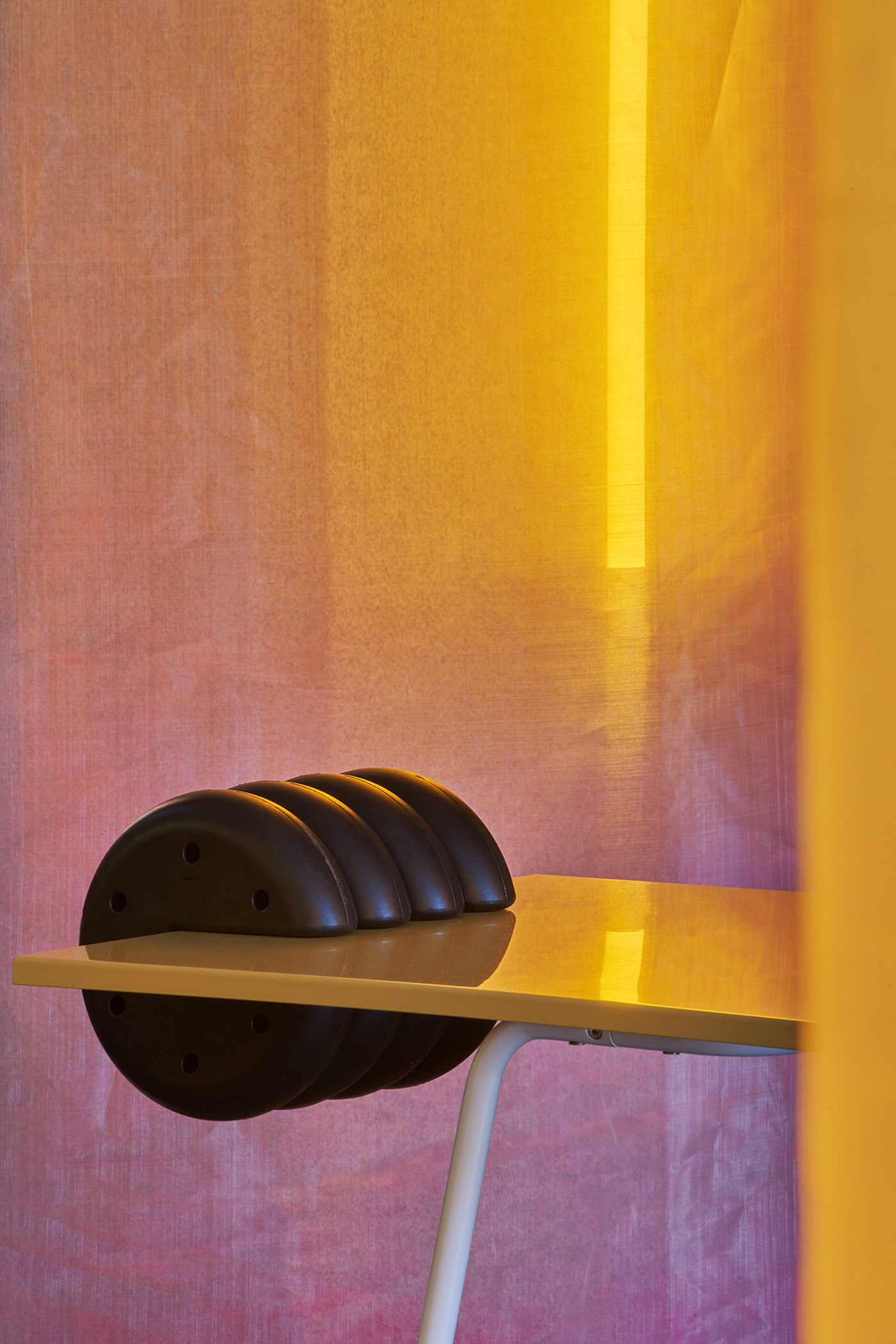A Room on Fire, Conde Duque, Madrid
With Lys Villalba
Client: Masquepalabras Collective
Collaborators: Matteo Caro, Jaime de la Torre, Enrique Sanz-Gadea
Textile Production: Candelas
Location: Multipurpose Room, Centro Conde Duque, Madrid (Spain)
Surface: 400sqm
Photographs: José Hevia

*Un cuarto en llamas (A Room on Fire)* is a space for dialogue and cultural creation aimed at a young audience interested in the arts -especially music, poetry, and utterance in general-. The project is located in a Multipurpose Room at the former military barracks of Conde Duque. It is an initiative of the Masquepalabras Collective, which manages it in collaboration with an assembly of young people, who design an autonomous and independent program. “Un cuarto en llamas” hosts a variety of cultural creation activities including concerts, conferences, workshops, performances, poetry readings, theater, videoart, debates, dance, streamings, etc.
The Multipurpose Room at Conde Duque is an open space with a basilica-like floor plan defined by three bays of granite columns, delimited by brick walls. As it is a listed building, all interventions on the pre-existing architecture are limited, prohibiting any alteration of the original elements or the mounting of pieces by means of holes or chemical adhesives.

How to convert the solemn materiality of this room into a space for poetic and artistic creation, how to transform its rigid configuration into a place under permanent construction that functions as a laboratory for experimentation and a community of communities, and how to do so without altering the building? To respond to these considerations, the project develops two complementary strategies: "Touchless design," and "Furniture Feat."

Office space. A Room on Fire, Conde Duque, Madrid. Photo by José Hevia

View from the offices to the auditorium. A Room on Fire, Conde Duque, Madrid. Photo by José Hevia

View of the colonnade with the lights on. A Room on Fire, Conde Duque, Madrid. Photo by José Hevia

View of the colonnade. A Room on Fire, Conde Duque, Madrid. Photo by José Hevia

View of the office space. A Room on Fire, Conde Duque, Madrid. Photo by José Hevia
Touchless Design: How to intervene in a building without touching it
From this starting condition, a space with a scenic character is designed using the minimum possible material and weight: the intervention must be done without touching the building. The heavy granite columns are dressed in 'tracksuits' of translucent plastic greenhouse fabric, degraded in pink and with neon lighting, which give a glimpse -or not- of what is going on behind, depending on the changing light conditions of the space. The new tracksuit columns are suspended in the air. A system of turnbuckles supported by four felt pads embraces the capital at the top, supporting itself at a mere 16 cm2. At the bottom, four weights complement the outfit and stabilize the pieces, whose three-meter-high zippered sides allow the space to be 'dressed and undressed'.


Photo by José Hevia

Photo by José Hevia

Photo by José Hevia

Photo by José Hevia

Photo by José Hevia

Photo by José Hevia
Feat. furniture: How to equip a space of collaborative production in constant change
The furniture takes its name from the abbreviation "featuring," used to indicate collaborations in musical creations. This system consists of 8 tables designed to be easily combined and rearranged. The furniture equips the room and transforms it, adapting it to different uses and activities. In the mornings, the tables form a collaborative workspace with computers. Like traditional "you-and-me" chairs where two people converse diagonally across from each other, the Feat. furniture is designed as "you-and-me-and-you" tables, where a total of three people can work at the computer and converse diagonally. This operation of relationality requires a change of proportions. The table becomes a very light and slender piece, equipped with points of light, which allows for fluid group work without the vision of the other being interfered with by the screens. The lightness of the furniture allows for easy reconfiguration. In the evenings, the Feat. furniture moves around the space, becoming dj tables, support for sound systems, equipment for workshops, debates and conferences, etc. Depending on the load that the table supports, a system of weights stabilizes the deformation that results from the large distance between the legs and the thinness of the wooden plank.

In short, Un cuarto en llamas is a space in continuous transformation, conceived from its use, and intervened in while inhabited. The Do-it-yourself spatial and material logics of this architecture are meant to accompany the self-managed cultural production of the community of young people who inhabit it.

Detail of table showing the lamp and the weights. Photo by José Hevia.

Detail of the weights hanging from the table. Photo by José Hevia.

Zipping the columns. Photo by José Hevia.

Photo by José Hevia

Photo by José Hevia

Photo by José Hevia